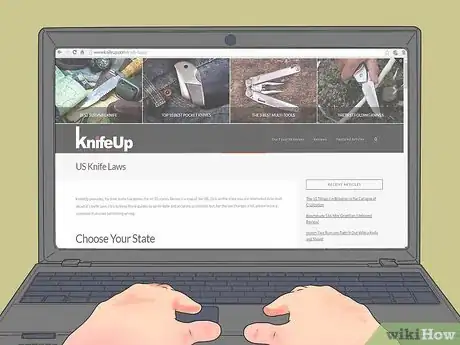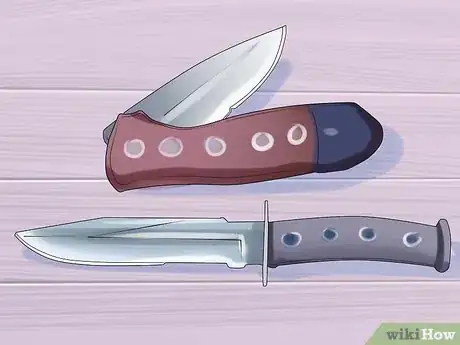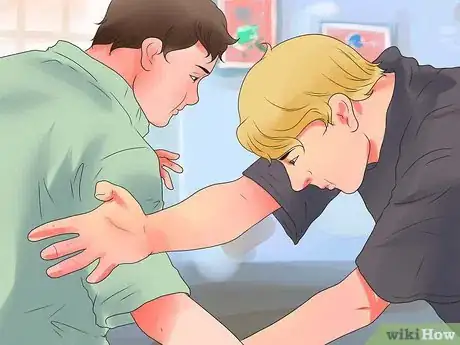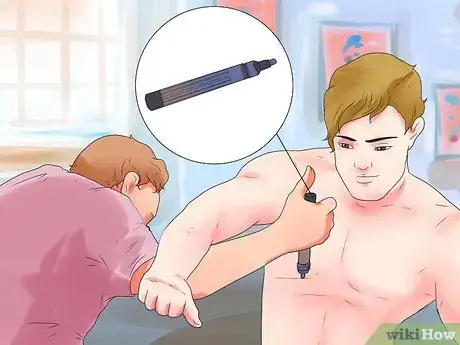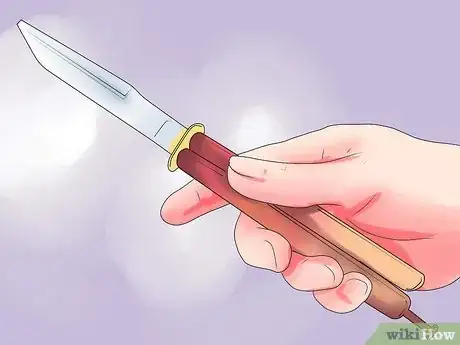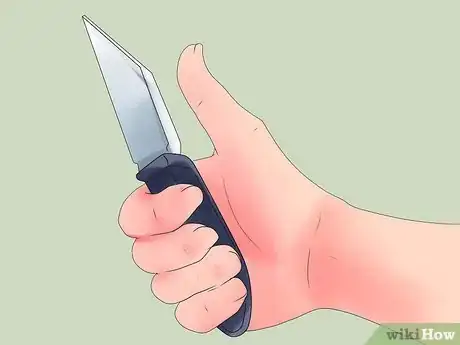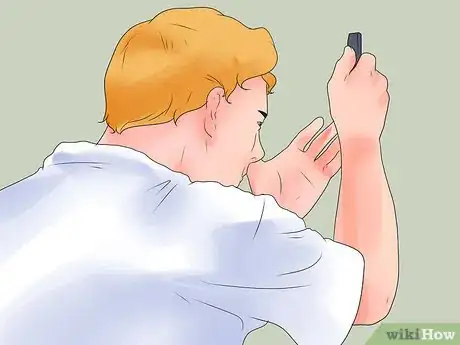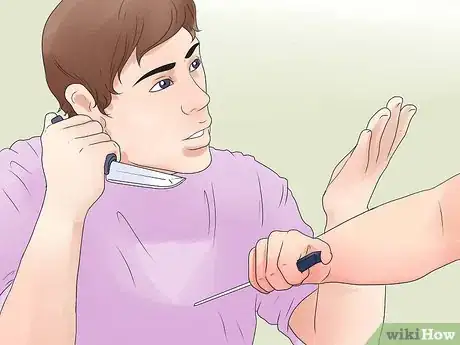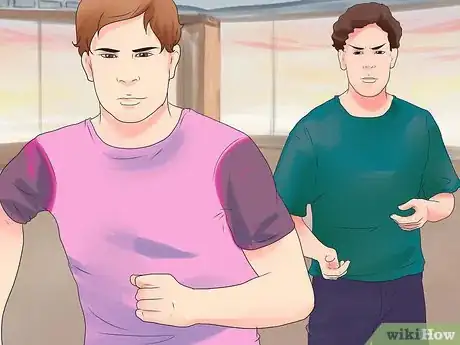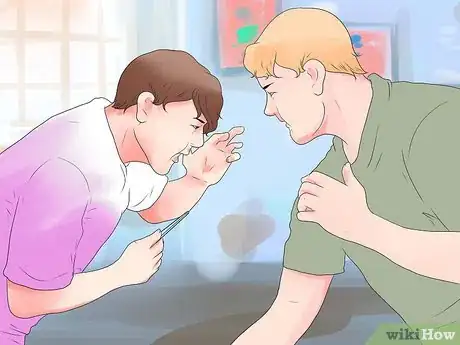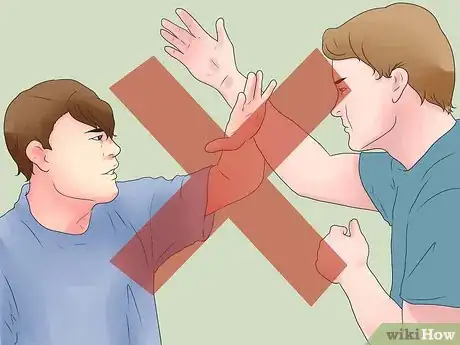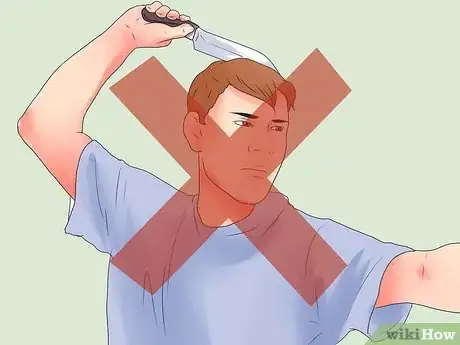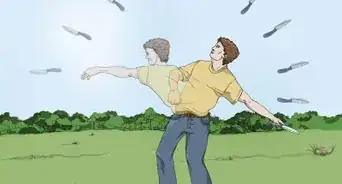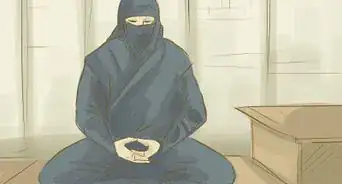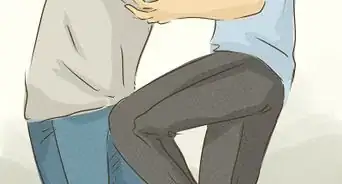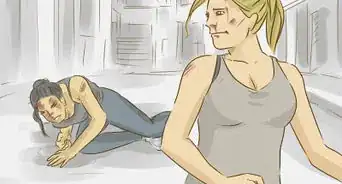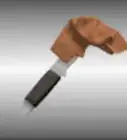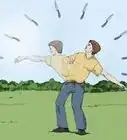This article was co-authored by Adrian Tandez. Adrian Tandez is the founder and head instructor of the Tandez Academy, a world-renowned self-defense training center in Mountain View, California. Trained under the renowned martial artist Dan Inosanto, Adrian is a certified instructor in Bruce Lee's Jeet Kune Do, Filipino Martial Arts, and Silat, among other things. Adrian has over 27 years of self defense training experience.
wikiHow marks an article as reader-approved once it receives enough positive feedback. In this case, 80% of readers who voted found the article helpful, earning it our reader-approved status.
This article has been viewed 602,838 times.
Knife fighting isn't about fighting, it's about surviving and defending yourself against attack. If you want to learn to defend yourself with a knife, you need intelligence, balance, and precision. You can learn to carry knives safely and legally, as well as how to defend yourself properly against potential attacks.
Steps
Carrying a Knife
-
1Learn the laws regarding carrying knives in your area. In most places, it's legal to carry most kinds of knives, both in the open and concealed, but if you want to start carrying a knife for self-defense it's important that you make sure to know the law of the land to protect yourself, legally and physically. In the United States, you can read about the laws from state to state by clicking here.
- In most places, Bowie knives, foldable knives, and other hunting-style knives are almost universally legal to own and to carry.
- Switchblades, dirks, stilettos, balisongs, cane knives, and other "misleading" styles of knife are treated variously. In some areas, it's legal to own these types of knife, but not legal to carry them.
-
2Choose an appropriate knife for self-defense. Generally, knife fighting and knife defense is performed with fixed blade knives, typically with blades 5-7 inches (12.7-17.78 cm) long, but it's important to size your defense knife to your hand and your fighting style. The techniques, however, will apply to almost any variety of knife, whether it be a fixed blade tactical knife, a foldable hunting knife, or other styles of knife.
- Grip a ruler to measure your grip from the second knuckle of your pointer finger to the second knuckle of your pinkie finger.[1] You want the grip of a good defense knife to match that size grip as closely as possible.
- Crocodile Dundee's words of wisdom do ring somewhat true in knife defense. A bigger, more intimidating knife can do more to keep you safe than the Swiss Army variety. Still, you can learn to defend yourself, regardless of what blade you carry.
Advertisement -
3Keep your knife clean and well maintained. A dull knife is a more dangerous knife, and it's important to keep all your knives–tactical, hunting, or kitchen–sharp, clean, and well-maintained. Learn to hone and sharpen your knives yourself, to keep them in good working order.
- Folding knives need to be oiled regularly to keep the action as smooth as possible.
-
4Get trained in self defense. If you introduce a knife into an altercation and don't know how to defend yourself, it's more likely that you're going to end up the one getting stuck. If you don't know how to defend yourself, you should not carry a knife for defense purposes. Take a general personal self defense class to learn to control your environment and stay calm in physical altercations.
- Knife and stick fighting courses are widely available in metro areas. Check out what's available and get detailed, one-on-one training to learn how to wield a knife properly and safely.
- Generally, you should look on a knife as an everyday tool that can be used for self defense, should someone provoke an altercation, and not as a weapon that solely for fighting. You should only draw your knife if your opponent also brandishes a knife. Furthermore, draw your knife only if you intend to use it. To use a weapon for intimidation will likely put the opponent into a fight or flight type response, and the momentum can change quickly in their favor. Draw and take action, or choose another course. Intimidation attempts (while potentially successful) give the opponent the opportunity to react and control the altercation.
- In most places, brandishing or drawing your knife in a threatening manner is a crime, punishable by fines and possibly jail time.
EXPERT TIPAdrian Tandez is the founder and head instructor of the Tandez Academy, a world-renowned self-defense training center in Mountain View, California. Trained under the renowned martial artist Dan Inosanto, Adrian is a certified instructor in Bruce Lee's Jeet Kune Do, Filipino Martial Arts, and Silat, among other things. Adrian has over 27 years of self defense training experience.Jeet Kune Do Instructor
 Adrian Tandez
Adrian Tandez
Jeet Kune Do InstructorIn Kali, which is Filipino martial arts, there is a lot of knife training. One of the things we teach is called defanging the snake, which means if someone tries to attack you with a knife, your number one objective is to disable the hand holding the weapon. So, if you have a knife, you would try to cut their weapon arm or hand with the goal of making them let go of the knife.
-
5Practice with markers. When you're first getting started learning about knife fighting, try a little experiment. Have someone much weaker than you: a smaller sparring partner, little brother, or even your daughter, and give them a permanent marker with the cap off. Take off your shirt and tell them to try to mark you as many times as possible while you try to stop them. Then count up the marker lines at the end. Now imagine that marker was a knife.[2]
- Even if you're experienced in self-defense, or even MMA, or karate, you're going to quickly come up against a hard truth: it's pretty easy for someone to get a blade on you in close quarters, and a knife makes for a deadly attacker, if you don't know what you're doing.
- This is an excellent way of practicing your knife fighting skills in perfect safety. Never attempt to practice knife fighting with a sharpened blade. Use markers or practice knives.
Defending Yourself with a Knife
-
1Evaluate your attacker. If you're going to carry a knife, you have to be sure you don't introduce it into the fight. Knives should only be drawn if you fear for your life in a physical altercation, because your opponent has also drawn a knife, gun, or another weapon in a threatening manner. Always use your knife first to attempt to avoid the altercation, then to defend yourself if necessary.
- Never draw knives on unarmed attackers. Learn to defend yourself without the use of a weapon, and avoid physical fights at all costs.
- If someone comes up to you in a threatening manner, look at their hands and at their pockets. If you see a weapon, draw your knife.
-
2Learn to draw your knife safely. When drawing a fixed-blade knife, make sure the blade points away from your body at all times. Maintain a firm grip on the handle, and extend the knife firmly up, out, and away from you to assume a defensive posture. Usually, most people carry the knife on the opposite side of the body as the dominant hand, for this purpose.
- Foldable knives can also be carried in on your pocket, though this can make drawing somewhat slow and cumbersome. Try getting a foldable knife with a quick-flip thumb stud to open it as quickly as possible, after drawing.
- There's no one way to carry and draw. A lot of this depends on personal preference. Experiment with different knives to get a feel for what's most comfortable for you.
-
3Grip your knife properly. There are a variety of different grips used for self-defense knife fighting, depending on preference. Practice drawing and holding your knife in the most comfortable and secure ways of possible, given your fighting style, strength, and the weight of your blade. The most basic and the easiest way to learn is probably the forward hammer grip.
- Forward grips involve holding the knife by the grip, your fingers wrapped completely around, and the blade facing out from you, pointing straight up at the sky. Variations on this grip mostly depend on where you put your thumb to reinforce, but the most basic is the hammer grip, in which you wrap your thumb around the grip, to secure the knife in your hand.
- Reverse grips are typically held in the exact same way, but with the blade pointing down toward the ground. It is possible to do a reverse grip with the blade edge pointing back at you, but this isn't recommended for beginners.
-
4Keep your body behind your knife. It's of the utmost importance that you use your knife as a defensive tool, protecting your face, neck, and torso against an attacker, at all costs.[3] Make your body as small as possible, by bringing your shoulders in and ducking your head, extending your knife-holding arm in front of you, flexed at a 45-degree angle.
- Don't extend your knife arm all the way, which will leave it vulnerable to attack.
- Use your other arm to guard your chest, neck, and stomach as you hide behind your knife. You don't want to offer your unarmed hand as some kind of shield or guard. Put your knife forward, always.[4]
-
5Move constantly. If you both draw knives, take a big step backward, but remain facing your opponent at all times, your knife between your body and your opponent. Imagine there was a magnet pointing your knife at your opponent's knife.
- In general, you can move one of four directions: forward, backward, and circling right or left. You should always be moving in some direction to protect yourself and make it more difficult to be struck. Never stand flat-footed.
-
6Use your knife as a distraction. Most attackers won't be interested in actually attacking you, especially if you just pulled a knife that you look like you know how to use. Nobody wants to actually get into a knife fight. If someone has pulled a knife on you and you've pulled a knife in return, that should hopefully be the end of it. Ideally, pulling your knife and distracting your opponent should be the end of the fight.[5]
- Draw your knife and issue a warning, something like: "This is a buck knife given to me by my tactical knife instructor, who works for Blackwater. I sharpen it every night. Trust me, you don't want to come anywhere closer. Let's just call it a night."
- Keith Richards, a famous knife enthusiast, liked to say that the only purpose of pulling a knife was to get someone to look at the knife as a distraction, before you ended the fighting by kicking them between the legs. Not the worst idea.
-
7Parry by dodging and controlling your opponent's striking arm. Knife-fighting doesn't much resemble sword fighting. You won't bang blades or do much parrying in a knife fight, but it's still important to deflect what could be a devastating blow by sidestepping blows, turning 90 degrees to the outside of your opponent's striking arm, then using your other hand to grip your opponent's elbow and attempt to disarm them.
- It's always preferable to use your knife to strike or block at your opponent's arm, rather than attempting to grab at them.
- If there's no other option, you do need to block with your other arm to protect your vital organs. A cut, even a severe one, on your arm is preferable to a stab wound in your solar plexus.
- Read the next section for more information about defensive striking to disarm your opponent.
-
8Always avoid fights if possible. Pulling and using your knife should be an absolute last resort, only taken if your life is being threatened. If you can avoid the confrontation entirely, or run, do this instead and avoid a potentially lethal situation.
- If you receive a bad cut or stab wound, put pressure on the wound immediately to attempt to stop the bleeding and seek medical attention. Maintain consistent pressure on the wound until you can get professional care.
Striking With a Knife
-
1Back out of striking range. A knife fight isn't about getting in close, it's about staying out of the way. Most of the fight will be you ducking and dodging, waiting for your moments to strike with quick little disarming strikes that will end the fight for good. If it looks like you're going to actually be attacked by someone with a knife, take a full step backward.
- Take a minute to evaluate your surroundings and move to open space. You need to be able to move backward with ease. If you're in cramped surroundings, it's going to be difficult to defend yourself.
-
2Attempt to disarm your attacker. Most inexperienced goons will take a wild slash somewhere close to your face, which should give you the first opportunity to stop the fight quickly when they make this mistake. When your opponent strikes, your counter-strike should be swift, accurate, and should end the fight immediately.
- If they slash low, toward your stomach, move with them, taking a big step back and to the side. As their arm is extended, bring your knife over their forearm, point down, and slash down with your blade at the wrist, attempting to get them to drop the knife.
- If they slash high, move with them, taking a big step back and to the side, then slash with your blade pointing up at the underside of their forearm. Aim for the forearm and wrist area, attempting to get them to drop the knife.
-
3Never use your other arm as a "shield." It's a common misconception that you want to block with your other arm, getting your opponent's knife out of the way, and then move in close for a strike. It seems to make sense, but one or two slashes at your "blocking" arm with an attacker's knife will have you losing blood and close to being incapacitated very quickly, making your "moving in" an unlikely proposition. Instead, you need to learn to use your knife to block and strike in single maneuvers.
- If you see an opportunity to grab your opponent's wrist with your opposite hand, that's another story, and you may want to take it.
- Obviously, if there's a situation that's extremely dire, you may need to offer up a sacrifice arm to protect your head and throat, but as your marker exercises suggest, it's going to get ugly really quickly. You need to be fast with your disarming strikes, and not get into something with more contact.
-
4Never throw your knife. The absolute last thing you want to do in a one-on-one knife fight is lose your knife. Defending yourself against an attacker with a knife when you don't have one is extremely difficult, as your marker exercise should have suggested. Actually striking someone with a thrown knife is extremely unlikely, and you're most likely to just lose your knife and end up in trouble. Keep your knife in your hand at all times.
Warnings
- If engaging in a knife fight, be prepared to accept any consequences, and that what you are fighting for is worth it. Stitches, surgery, and perhaps a slow and painful death may await the person who loses.⧼thumbs_response⧽
- Don't expect a fair fight. Most knife fights are not head-on, so it's not uncommon for an attacker to run up behind you or attack from the side without warning.⧼thumbs_response⧽
- Using a knife in most countries is not an act of self defense, possibly unless your opponent is also armed with their own knife or a gun, and you will be put in jail for using a knife.⧼thumbs_response⧽
- Be aware, if you are defending against someone who does not have a knife, and you pull a knife, s/he may use it as a weapon against you, if the person has the ability to take it away. If you are not in mortal fear for your life, you might want to reconsider such an action.⧼thumbs_response⧽
- You should only get into a knife fight if you are defending yourself and your attacker has a knife as well; you shouldn't be the person on offense, and you should try to run away if you can.⧼thumbs_response⧽
- In the UK, carrying a knife in public is illegal, except in "reasonable circumstances".⧼thumbs_response⧽
- Never carry or possess knives that are illegal in your jurisdiction. Switchblades (a knife which opens with a press of a button) are often illegal, as well as butterfly knives (knives where the handle is made of two parts, and the blade connects at the handle's joint). Remember to always check with your local police department before trying to carry a knife in public.⧼thumbs_response⧽
- Never throw your knife if you aren't 100% certain it will hit, or if you are fighting more than one person. if you can hit a target even 99% of the time there is still a 1% chance of losing your knife and, chances are, you will not be able to hit the target 99 times out of 100.⧼thumbs_response⧽
- Call Emergency Services when you use a knife to easily protect yourself against assault, aggravated assault, and, potentially, murder charges.⧼thumbs_response⧽
- The use of a knife is illegal unless it's used:
- To stop the person from posing a threat of great bodily harm or deadly force to anyone, including oneself
- For apprehending people who are clearly doing something illegal (especially a felony), and the suspect poses a threat of great bodily harm or deadly force during the commission of the crime and/or to resist the detention, and
- As a police officer to arrest people who pose a threat of great bodily harm or deadly force during the commission of the crime and/or to resist the arrest.
⧼thumbs_response⧽
References
- ↑ http://www.jayfisher.com/Knife_Grip_Styles_Hand_Sizing.htm#What_grip_technique_do_I_use
- ↑ http://www.survivalschool.us/knife-fighting-for-self-defense/
- ↑ http://www.sammyfranco.com/knife-fighting-techniques.html
- ↑ http://www.msisshinryu.com/articles/safreed/knife_fighting.shtml
- ↑ http://www.nononsenseselfdefense.com/knifefighter.html
About This Article
Before you learn how to defend yourself with a knife, look up weapon laws to find out what knives are legal to carry in your area. Then, pick a knife that’s appropriate for self-defense, like a fixed blade that’s 5 to 7 inches long. When drawing a fixed-blade knife, make sure the blade points away from your body at all times. Maintain a firm grip on the handle, and extend the knife firmly up, out, and away from you. Keep your body behind your knife at all times to avoid harming yourself or being disarmed by your attacker. If your attacker moves in to hit or harm you, move with them, taking a big step back and to the side, then bring your knife to their forearm or wrist to either disarm them or harm them enough to escape. To learn how to use your knife as a distraction during a fight, keep reading!
